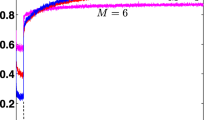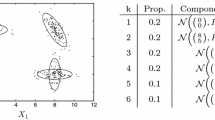Abstract
In this article, the “elbow method” and the “average silhouette” algorithms are used for determining an optimal number of clusters. A “shifted” EM algorithm adapted to the number of clusters is put forward, which allows increasing accuracy of the Gaussian mixture distribution approximation that determines the probabilistic structure of the interference distribution. Dependencies of an average number of cycles and the Kullback–Leibler divergence on a number of clusters in an initial mixture are obtained via mathematical modeling with a preset range of parameters. A comparative analysis of the EM algorithm results is carried out.
Similar content being viewed by others
References
Chabdarov, Sh.M. and Trofimov, A.T., Poly-Gaussian Representation of Arbitrary Noise and the Discrete Signal Detection, Radiotekhnika i Elektronika, 1975, vol. 20, no. 4, pp. 734–735.
Kozlov, S.V., Novye smesevye podkhody k proektirovaniyu radiointerfeisa sistem svyazi (New Mixing Approaches to Design of the Communication System Interface), Kazan: Novoe Znanie, 2014.
Faizullin, R.R., Kadushkin, V.V., and Zaripov, R.F., A Poly-Gaussian Algorithm for Joint Demodulation in Mobile Communications, Nelineinyi Mir, 2015, vol. 13, no. 8, pp. 4–9.
Faizullin, R.R., Kadushkin, V.V., and Vorob’ev, M.S., Synthesis of Poly-Gaussian Quasioptimal Algorithms for Multiuser Detection Problem and Non-Gaussian Interference, Izv. Vuz. Av. Tekhnika, 2015, vol. 58, no. 3, pp. 93–98 [Russian Aeronautics (Eng. Transl.), vol. 58, no. 3, pp. 345–350].
Kadushkin, V.V., Algorithm of the Optimal Detection in Non-Gaussian Channels of CDMA Systems Considering the Intra-System Interference, Zhurnal Radioelektroniki, 2016, no. 11, URL: https://doi.org/jre.cplire.ru/jre/nov16/11/text.pdf
Chabdarov, Sh.M., Nadeev, A.F., and Faizullin, R.R., Post-Correlation Probabilistic Models in the Problem of Signal Discrimination for Modern Information and Communication Systems, Izv. Vuz. Av. Tekhnika, 2014, vol. 57, no. 2, pp. 49–53 [Russian Aeronautics (Eng. Transl.), vol. 57, no. 2, pp. 175–180].
Nadeev, A.F. and Podkurkov, I.A., Adaptive Estimation of Parameters of Distribution of Non-Gaussian Interferences Through the Application of the EM Algorithm and Its Modifications, Nelineinyi Mir, 2015, vol. 13, no. 8, pp. 64–72.
Chabdarov, Sh.M., Nadeev, A.F., Faizullin, R.R., Efimov, E.N., and Adnan, A., Polycorrelation Distributed Adaptive Signal Processing in a Presence of Non-Gaussian Interferences, Nelineinyi Mir, 2009, vol. 7, no. 5, pp. 355–359.
Insarov, A.Y., Faizullin, R.R., Yaushev, S.T., and Lerner, I.M., Simulation of Effectiveness of the Channel Resources Evaluation Algorithm Founded on the Basic Model of Multiservice Network, Proc. Conf. Systems of Signals Generating and Processing in the Field of on Board Communications, Moscow, 2018, URL: https://doi.org/ieeexplore.ieee.org/document/8350597.
Bishop, C.M., Pattern Recognition and Machine Learning, N.Y: Springer Science–Business Media, 2006.
McLachlan, G.J. and Krishnan, T., The EM Algorithm and Extensions, USA: John Wiley&Sons, 2008.
Korolev, V.Yu., EM-algoritm, ego modifikatsii i ikh primenenie k zadache razdeleniya smesey veroyatnostnykh raspredeleniy. Teoreticheskiy obzor (EM Algorithm, Its Modifications and Application to the Task of Separation of Mixtures of Probabilistic Distributions, Theoretical Review), Moscow: IPI RAN, 2007.
Celeux, G., Chauveau, D., and Diebolt, J., Stochastic Versions of the EM Algorithm: an Experimental Study in the Mixture Case, Journal of Statistical Computation and Simulation, 1996, vol. 55, no. 4, pp. 287–314.
Kodinariya, T.M. and Makwana, P.R., Review on Determining Number of Cluster in K-Means Clustering, Int. Journal of Advance Research in Computer Science and Management Studies, 2013, vol. 1, no. 6, pp. 90–95.
Vorontsov, K.V., Matematicheskie metody obucheniya po pretsedentam (teoriya obucheniya mashin) (Mathematical Learning Methods by Precedents (Machine Learning Theory)), URL: https://doi.org/www.machinelearning.ru/wiki/images/6/6d/Voron-ML-1.pdf.
Author information
Authors and Affiliations
Corresponding author
Additional information
Original Russian Text © R.R. Faizullin, S.T. Yaushev, A.Yu. Insarov, R.F. Zaripov, M.M. Fatykhov, 2018, published in Izvestiya Vysshikh Uchebnykh Zavedenii, Aviatsionnaya Tekhnika, 2018, No. 3, pp. 157–163.
About this article
Cite this article
Faizullin, R.R., Yaushev, S.T., Insarov, A.Y. et al. Performance Analysis of the EM Algorithm in Conjunction with Algorithms for Determining an Optimal Number of Clusters and Their Centroids, Which Allows Estimating Parameters of Non-Gaussian Interference in Mobile Communication Systems. Russ. Aeronaut. 61, 487–494 (2018). https://doi.org/10.3103/S106879981803025X
Received:
Published:
Issue Date:
DOI: https://doi.org/10.3103/S106879981803025X




